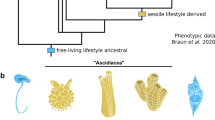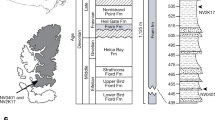Abstract
Like the Burgess Shales of Canada, the Chengjiang Lagerstätte from the Lower Cambrian of China is renowned for the detailed preservation as fossils of delicate, soft-bodied creatures1,2,3,4,5,6,7,8,9, providing an insight into the Cambrian explosion. The fossils of possible hemichordate chordates5,6,7 and vertebrates9 have attracted particular attention. Tunicates, or urochordates, comprise the most basal chordate clade10, and details of their evolution could be important in understanding the sequence of character acquisition that led to the emergence of chordates and vertebrates11,12,13,14,15,16,17,18. However, definitive fossils of tunicates from the Cambrian are scarce or debatable4,9,19,20,21,22,23,24. Here we report a probable tunicate Cheungkongella ancestralis from the Chengjiang fauna. It resembles the extant ascidian tunicate genus Styela whose morphology could be useful in understanding the origin of the vertebrates.
This is a preview of subscription content, access via your institution
Access options
Subscribe to this journal
Receive 51 print issues and online access
$199.00 per year
only $3.90 per issue
Buy this article
- Purchase on Springer Link
- Instant access to full article PDF
Prices may be subject to local taxes which are calculated during checkout

Similar content being viewed by others
References
Shu, D.-G., Geyer, G., Chen, L. & Zhang, X.-L. Redlichiacean trilobites with preserved soft-parts from the Lower Cambrian Chengjiang fauna. Beringaria Spec. Iss. 2, 203–241 (1995).
Shu, D.-G., Zhang, X. & Geyer, G. Anatomy and systematic affinities of Lower Cambrian bivalved arthropod Isoxys auritus. Alchringa 19, 333–342 (1995).
Hou, X. & Bergstrom, J. Arthropods of the Lower Cambrian Chengjiang fauna, southwest China. Fossils Strata 45, 1–115 (1997).
Zhang, X.-L., Shu, D.-G., Li, Y. & Han, J. New sites of Chengjiang fossils: crucial windows on the Cambrian explosion. J. Geol. Soc. Lond. 158, 211–218 (2001).
Chen, J.-Y., Dzik, J,, Edgecombe, G. D., Ramskoeld, L. & Zhou, G.-Q. A possible early Cambrian chordate. Nature 377, 720–722 (1995).
Shu, D.-G. & Zhang, X.-L. Reinterpretation of Yunnanozoon as the earliest known hemichordate. Nature 380, 428–430 (1996).
Shu, D.-G., Conway Morris, S. & Zhang, X.-L. A Pikaia-like chordate from the Lower Cambrian of China. Nature 384, 156–157 (1996).
Shu, D. et al. A pipiscid-like fossil from the Lower Cambrian of South China. Nature 400, 746–749 (1999).
Shu, D. et al. Lower Cambrian vertebrates from South China. Nature 402, 42–46 (1999).
Cameron, C. B., Garey, J. R. & Swalla, B. J. Evolution of the chordate body plan: new insights from phylogenetic analyses of deuterostome phyla. Proc. Natl Acad. Sci. USA 97, 4469–4474 (2000).
Garstang, W. The morphology of the Tunicata and its bearing on the phylogeny of the Chordata. J. Microscop. Soc. 72, 51–87 (1928).
Romer, A. S. The Vertebrate Story (Univ. Chicago Press, 1971).
Gee, H. Before the Backbone: Views on the Origins of Vertebrates (Chapman and Hall, London, 1996).
Ogasawara, M., Di Lauro, R. & Satoh, N. Ascidian homologs of mammalian thyroid transcription Factor-1 gene expressed in the endostyle. Zool. Sci. 16, 559–565 (1999).
De Gregorio, A. & Levine, M. Ascidian embryogenesis and the origins of the chordate body plan. Curr. Opin. Genet. Dev. 8, 457–463 (1998).
Swalla, B. J. et al. Urochordates are monophyletic within the deuterostomes. System. Biol. 49, 52–64 (2000).
Nielsen, C. Animal Evolution: Interrelationships of Living Phyla (Oxford Univ. Press, Oxford, 1997).
Conway Morris, S. in Atlas of the Burgess Shale (ed. Conway Morris, S.) 26 (Palaeontological Association, London, 1982).
Briggs, D. E. G. et al. The Fossils of the Burgess Shale (Smithsonian, Washington, 1994).
Satoh, N. Developmental Biology of Ascidians (Cambridge Univ. Press, New York, 1994).
Mueller, K. J. Palaeobotryllus from the Upper Cambrian of Nevada—a possible ascidian. Lethaia 10, 107–118 (1977).
Lehnert, O., Miller, J. F. & Cochrane, K. Alaeobotryllus and friends: Cambro-Ordovician record of probable ascidian tunicates. Acta Univ. Carol. Geol. 43, 447–450 (1999).
Lohmann, H. Oesia disjuncta Walcott, eine Appendicularie aus dem Kambrium. Mitt. Zool. Mus. Hamburg 38, 69–75 (1922).
Zhang, A. Fossil appendicularians in the early Cambrian. Scient. Sinica B 30, 888–896 (1987).
Meglitsch, P. A. & Schram, F. P. Invertebrate Zoology 3rd edn, 576–587 (Oxford Univ. Press, 1991).
Wada, H. & Satoh, N. Details of the evolutionary history from invertebrates to vertebrates, as deduced from the sequences of 18S rDNA. Proc. Natl Acad. Sci. USA 91, 1801–1804 (1994).
Berrill, N. J. The Origin of Vertebrates (Oxford Univ. Press, Oxford, 1955)
Carter, G. S. Chordate Phylogeny. Syst. Zool. 6, 187–192 (1957).
Jollie, M. What are the ‘Calcichordata’? and the larger question of the origin of chordates. Zool. J. Linn. Soc. 75, 167–188 (1982).
Wada, H. Evolutionary history of free-swimming and sessile lifestyles in urochordates as deduced from 18S rDNA molecular phylogeny. Mol. Biol. Evol. 15, 1189–1194 (1998).
Acknowledgements
This work is supported by the Ministry of Sciences and Technology of China, National Natural Science Foundation of China, Ministry of Education of China and Cheung Kong Scholars Programme, Sciences and Technology Committee of Shaanxi Province, and National Geographic Society, USA. We are grateful to B. J. Swalla and S. Conway Morris for suggestions. We thank N. Satoh, K. Yasui, H. Wada, R. P. S. Jefferies and S. M. Shimeld for remarks. We also thank Z. Luo, Z. Zhang, L. Guo, F. Yao and H. Liu for technical assistance.
Author information
Authors and Affiliations
Corresponding author
Rights and permissions
About this article
Cite this article
Shu, DG., Chen, L., Han, J. et al. An Early Cambrian tunicate from China. Nature 411, 472–473 (2001). https://doi.org/10.1038/35078069
Received:
Accepted:
Issue Date:
DOI: https://doi.org/10.1038/35078069
This article is cited by
-
A phylogenomic framework and timescale for comparative studies of tunicates
BMC Biology (2018)
-
Meiofaunal deuterostomes from the basal Cambrian of Shaanxi (China)
Nature (2017)
-
Fibronectin contributes to notochord intercalation in the invertebrate chordate, Ciona intestinalis
EvoDevo (2016)
-
Facts and fancies about early fossil chordates and vertebrates
Nature (2015)
-
Dermatan sulfate in tunicate phylogeny: Order-specific sulfation pattern and the effect of [→4IdoA(2-Sulfate)β-1→3GalNAc(4-Sulfate)β-1→] motifs in dermatan sulfate on heparin cofactor II activity
BMC Biochemistry (2011)
Comments
By submitting a comment you agree to abide by our Terms and Community Guidelines. If you find something abusive or that does not comply with our terms or guidelines please flag it as inappropriate.



